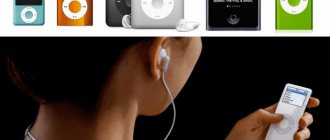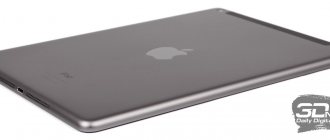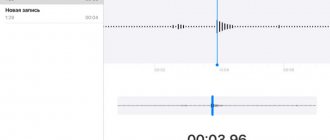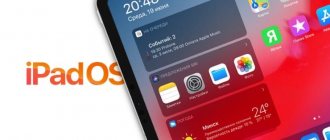Modern iPads are loved for the convenient consumption of visual content on a relatively large screen, for the few truly high-quality mobile games, and for interesting applications for children and their parents. But all the use cases described above can be implemented using a smartphone or laptop - which is why many do not understand why they need another device that duplicates their capabilities. However, Apple continues to sell its branded tablets and does so quite successfully. Here it is - an excellent occasion to remember how the iPad line appeared and developed.
Subscribe to our Zen
Subscribe to our Zen
2010: iPad
Steve Jobs at the presentation of the first iPad | Wired
During the presentation of Apple's first tablet in 2010, Steve Jobs asked those in attendance if there was room for a new category of gadgets somewhere between the iPhone and MacBook. I assume that the majority was ready to answer this question in the negative. However, the iPad, whatever one may say, proved the opposite.
The aluminum body of Apple's first tablet is very tactilely reminiscent of today's iPad Pro. Yes, the current flagship line is noticeably thinner, but the chopped side edges inevitably create associations. The body of the original iPad was made of aluminum; the mobile device was equipped with a 9.7-inch IPS screen, which was surrounded by an impressive black frame. Interestingly, this device did not have a front or rear camera - apparently, Apple had not yet decided why they might be needed.
Original iPad | Elias Makos
The manufacturer's first tablet was equipped with three storage options: 16 GB, 32 GB or 64 GB. It had a fairly powerful Apple A4 chipset for that time, as well as an impressive battery life: as much as 10 hours without connecting to power - fantastic from 2010.
Interesting facts about this iPad model:
- even after the release of the first iPad, iOS had a different name, iPhoneOS - however, after the operating system became truly universal for two categories of gadgets, a more concise and universal name had to be chosen for it;
- For the first iPad, Apple released a special docking station that made it easier to use the tablet with a keyboard or as a photo frame:
About feelings
Never try to compare the iPad mini with its 9-inch brother, because we are looking at two completely different products. It's like trying to make a difficult choice between buying a convertible or an SUV - each is good for your needs. Everything is much simpler.
The main task of the iPad mini is to bring pleasure to its owner in those moments when the hand is tired of the iPad 3. Old Newton also knew how to do this.
iPad mini is a phoenix, reborn again after 14 years.
In 1977, business angel and Apple's first major investor Mike Markkula had a long conversation with an overgrown and smelling Steve Jobs. Mike said the following:
You can create the best product, the highest quality, the most useful program, and so on; but if you present it casually, the attitude towards it will be appropriate. If we present our product creatively and professionally, we will instill the attitude we need.
Steve Jobs remembered the lesson and then often blew the minds of designers, demanding that they create the perfect packaging that would convey tactile sensations, beauty and set the tone for the perception of the product.
When I received the iPad mini box, I was amazed at how perfect it was. I don’t even want to open such things. This is perhaps the best box Apple has ever created. Believe me, I have something to compare with.
I use boxes from the first and third models to store all sorts of nonsense. They do not evoke any feelings or trust in me.
In the box from the iPad mini I will put something dear to me - for example, an iPhone 2G.
I think that if the company had paid more attention to packaging when creating Newton, the PDA would have found a response in the hearts of customers. Now, looking at the past and present, my soul becomes warm. Phoenix gives me a piece of this warmth.
We remove the film and open the lid to feel deja vu: we saw the same thing in the iPhone, only there are no headphones: a charger, a meter-long lightning, two stickers and some printing with basic tips for beginners.
When turned on, the Apple server determines your location by the IP address of the Wi-Fi network, and the iPad mini immediately offers a Russian menu with the Cyrillic keyboard enabled. The battery is 96% charged! If you have Wi-Fi at home, then activating the gadget will only take a minute, after which you will see a standard desktop.
Of course, I immediately took out the iPad 3 and started comparing sizes, thickness, and display quality. It turned out like this:
And even like this:
But at some point I managed to stop and ask myself the most important question for the next three days: what the hell am I doing ? The iPad mini will obviously lose out in terms of hardware to the iPad 3, just as the Audi TT will lose out in the cross-country ability of the Land Rover Discovery. The iPad mini has different tasks.
After which the large iPad was put aside, and its place was taken by a gadget that I never part with - the Amazon Kindle. This is a more real competitor, because it is also convenient to hold in one hand. It is just as compact and is designed only for content consumption.
I remember the article in Time magazine about the first iPad, which infuriated Steve Jobs. It said "that, while a delightful device for consuming content, it [the iPad] is not particularly conducive to its creation." Let's remember with a good word Lev Grossman, who wrote such an important thought in the line above. The head of Apple wanted to see the iPad in the hands of those who are changing this world, and not walking in a herd, chewing and mooing as they go. In his philosophy, Apple products contributed to the creation of beauty. The nasty Time destroyed the entire mosaic with its publications.
Steve Jobs ordered immediate porting of the Mac iLife package to iOS. As a result, we now use mobile versions of GarageBand and iMovie, as well as many other third party apps to get creative with!
You can really create music and home movies on a 9-inch large screen. On 7 inches it is also possible, but not as convenient. But you can take the iPad mini with you on any trip.
I bet you won't get there...
I often remember picnics when I was forced to abandon the iPad 3 because of its size: the tablet did not fit into my stuffed gym bag. This will not happen with the iPad mini, because it easily fits even into jacket pockets.
Before the New Year's fairy tale, Apple reinvented the irreplaceable companion. On the subway, it is convenient to read a book in a horizontal position on a small screen. In low artificial light, the iPad mini outperforms the Kindle.
But in the natural world, alas, “electronic paper” is still invincible. It has better contrast and no glare.
The new tablet is perfect for typing text with both hands! With the iPad 3, such a trick only led to curses and the fear of dropping the gadget from your hands. Want a retina display? Then here is a battery of increased capacity and a weight of 350 grams more.
The volume of the iPad mini's external speakers is almost the same as that of the older model. However, the “treshka” transmits bass better due to the vibration of its large body.
Why didn't I say a word about stereo? Because this is complete nonsense. Firstly, what kind of stereo can there be when there are only 2 centimeters between the speakers? Secondly, there is not much software in the App Store that will let you experience the stereo sound of the iPad mini. The only explanation for the existence of two speakers is that now Apple has eliminated the need to twirl the tablet in your hands so as not to block the sound with your palm during arcade games, racing games and shooters. Do you love consuming content and spending your time playing games? – please, we add another 20 horsepower to your life paradigm. Play to your heart's content, in any position. Even in the bathroom, because the tablet is so light.
I am sure that many games will find a second wind on the iPad mini. Mini works very quickly with its two graphics cores.
Its camera allows you to take acceptable pictures. Of course, not the iPhone 5, but still worthy.
Clickable. Compare with
, made on iPhone 5.
And make videos. The short video below shows close-up and long-range shooting, shooting of people and objects.
To make a decision in favor of buying or refusing Apple products, you must first talk to her in private. iPad mini is good not only for adults, but also for children (they have small hands). Personally, my children are no longer suitable for the iPad 3, which I am incredibly happy about: finally, dad will get down to business.
I tried to avoid playing too much with numbers in order to convey my tender feelings for the “baby”. I don't like him. It was as if there were fish or a guinea pig in the house. Continuous “mi-mi-mi”, happy children and wife.
What if you want numbers? Let's ask my colleague , who with sparkling eyes rushed by fast train from Chernigov to Moscow to be the first to touch the mini with the hands of an avid gadget addict.
2011: iPad 2nd generation
iPad 2nd generation under its predecessor | AnandTech
Against the backdrop of the successful launch of the first tablet model, a year later Apple hastened to release the second. I personally consider the 2nd generation iPad to be the most successful for several reasons: firstly, it received updates for a long time (five and a half years) - it came out on iOS 4.3, but was able to switch to iOS 9.3.6; secondly, its design is actually still used today - even the basic 8th generation iPad, which was introduced in 2022, is still very similar to it; thirdly, I myself know more than one person who still uses this gadget to watch YouTube, movies and TV series - almost 10 years after its launch.
Back of iPad 2nd generation | AnandTech
The iPad 2 had several important innovations that made it so successful: built-in front and rear cameras, which were not present in its predecessor, a couple of times faster Apple A5 chipset, as well as a third less weight and much more elegant shapes.
Interesting facts about this iPad model:
- Unlike today, back then cameras were, to a greater extent, intended only for video communication via FaceTime.
Harsh CPU Reality
Read about hardware in the visual material “iFixit dismantled the iPad mini”
The reality, as usual, turned out to be much more prosaic. Apple, of course, did not release a “cheap hardcore” device, but a completely technically modern device, but there is nothing unexpected about it. In general, everything is as always: the device contains exactly the same filling, which will be enough for comfortable work with the gadget for the next year, that is, until the release of the next generation. But, on the other hand, there was a place in the iPad mini for “One more thing”. Well, let's take a look inside the small, thin and light tablet.
In fact, the iPad mini’s hardware was created a little over a year and a half ago, when the iPad 2 entered the market. It was its processor, or, more correctly, the Apple A5 , that formed the basis of the iPad mini. Although this is not an exact copy of the original SoC, but a modified version of it, made in compliance with the 32 nm process technology, versus 45 nm in the first version of the chip. The finer the manufacturing process, the less the final product consumes and the smaller the chip dimensions. By the way, the iPad 2 has also been using this 32 nm Apple A5 since the spring of this year.
As for the power of the SoC, it is quite impressive even after a year and a half. The iPad's hardware turned out to have a decent margin of safety, although this is not in Apple's rules. But at that time, by equipping the tablet with very powerful hardware, the company saved on the display; the newcomer got it from its predecessor. In turn, the third generation iPad received a super display, but its SoC, in fact, differs only in a couple of additional cores in the GPU and twice the amount of RAM. Even the name is almost old - Apple A5x. But the iPad 4Gen has already been equipped with an uberprocessor that tears all modern SoCs to shreds. Its display is still the best in its class. Notice how clearly the spiral of history is visible: iPad (like iPhone 4, but less memory) - iPad 2 (super processor, but old display) - iPad 3Gen (almost old processor, but super display) - iPad 4Gen (super processor and still very cool and not an outdated display). And the iPad mini at the moment turned out to be not great, but still a balanced solution. Let's take a closer look at it.
The Apple A5 system-on-chip is built on two Cortex-A9 with a frequency of 1 GHz, complemented by a 2-core PowerVR SGX543MP2 and 512 MB of RAM. When compared with modern 4-core SoCs, like NVIDIA Tegra 3 (Nexus 7) or Samsung Exynos 4x (Galaxy S III, Galaxy Note II), the A5 solution lags behind by about half in terms of computing power due to two cores (slightly more in the case of with Exynos due to the higher frequency), while competitors have four. But in terms of graphics performance, Apple's solution is 20-25% faster than GeForce in Tegra 3, and approximately on par with Mali-400 in Exynos. That is, if we compare it by bare numbers, even today the iPad mini’s internals look very vigorous and this vigor will be quite enough for the next year. You can complain about 512 MB of RAM, but that amount in iOS is equivalent to 1 GB in Android, if not more efficient.
2012: iPad 3rd generation and iPad 4th generation, iPad mini
iPad 4th generation | iMore
As with smartphones, things haven't always been smooth sailing for Apple's tablets. A striking example is the 3rd generation iPad, which the company launched at the beginning of 2012. Its main innovation was twice the resolution in height and width - four times more pixels on the screen and the name Retina. The company wanted to ensure that individual dots on the gadget’s display were not visible, and it did this - 264 PPI, taking into account the average distance to the eyes during use, was more than enough. However, the gadget received the Apple A5x chipset - it was ahead of its predecessor, but still could not cope with the increased load by 100%.
It was because of insufficient performance that the company launched the 4th generation iPad in the second half of the same year. In addition to the up to two times faster chipset, Apple A6x, the new product also received a Lightning port, to which a large-scale transition began, including in the iPhone.
The first iPad mini | iPad Insight
In the same year, Apple launched a new tablet format - the 7.9-inch iPad mini. It received the screen resolution and chipset from the 2nd generation iPad - in fact, it became its hardware copy in a smaller body. It had more than enough performance at the time, and many people really liked its size.
Interesting facts about these iPad models:
- The 3rd generation iPad is very similar to the iPhone X in some ways - both devices were on sale for less than a year;
- At the time of the release of the 3rd generation iPad, the App Store already had more than 200 thousand applications tailored specifically for the device’s large screen.
Education and other use cases
The iPad is used for more than just entertainment. It has brought changes to the workplace and entire industries. The tablet is widely used in inventory and sales. In restaurants, the waiter can record your order on an iPad. It can be found everywhere in IT, marketing and construction. It had a particularly strong impact on two industries. In healthcare, the iPad provides portable access to images, test results, and patient records. It allows you to see high-definition images for diagnosis, imaging and communication with patients. iPad lets you interact with wireless health monitoring devices, including the Apple Watch.
iPad goes with me everywhere
In education, the iPad has impacted both teachers and students. For schoolchildren and students, it increased the level of involvement and interest in subjects. With competition from Google apps and cheap Chromebooks, iPad apps and available resources are making teachers' jobs easier and changing the way they teach.
2013: iPad Air, iPad mini 2nd generation
First iPad Air | Apple Investigator
In 2013, Apple slowed down its line of basic tablets and launched the first iPad Air model. It turned out to be much more modest in size than the 4th generation iPad and approximately 20% lighter. He adopted many of the features of the iPad mini line - for example, the location of the cutouts for the speakers on the bottom of the side frame. As for the characteristics, in many ways the gadget repeated its predecessor. However, the device was powered by Apple's 64-bit A7 chipset, which was part of the company's overall shift away from 32-bit architecture. What’s interesting is that competitors didn’t even think about anything like that back then, but Apple confidently implemented it.
iPad mini 2nd generation | PhoneArena
Another interesting gadget this year was the 2nd generation iPad mini, which received not only the same chipset, but also a Retina screen. It had a record pixel density for tablets at that time - 326 PPI. Of course, if it was possible to see individual points, it was only from a minimal distance.
Interesting facts about these iPad models:
- 326 PPI - this screen density was found not only in the 2nd generation iPad mini from 2013, but also, for example, in the iPhone 11 from 2019.
Sales statistics
The first iPad got off to a pretty good start. In the first weekend, 300 thousand tablets were sold, in the 1st quarter - 3.27 million, in the financial year 2011 - 32 million copies. Since it is a consumer device, iPad sales always increase during the holiday season. iPad Air and iPad mini2 showed record sales in November 2013, more than 26 million per quarter. At the end of 2018, Apple stopped providing statistics on iPad sales, but since the introduction of the first model, more than 400 million copies have been sold.
iPad accounted for 26% of Apple's total revenue in Q3 2012. Since then, other market segments have grown faster than the iPad. In Q4 2022, it accounted for just 11% of the company's revenue. Thanks to model updates in 2018-19, Q2 2022 recorded its highest growth in 6 years. iPad revenue grew 22% to 21.3 million. If iPad were a standalone (largest US corporations) it would be in 147th place.
iPad sales 2010-2018
2014: iPad Air 2nd generation, iPad mini 3rd generation
iPad Air 2nd generation | iMore
With the release of the 2nd generation iPad Air, it became clear that Apple was trying to reduce the thickness of its gadgets as much as possible - it was 6.1 mm. It was really difficult to find a thinner mobile device in the mobile market and this was truly surprising.
iPad mini 3rd generation | iMore
The 3rd generation iPad mini was a truly minor update to the previous model in the line. Most of its hardware capabilities remain at the level of its predecessor. The only thing is that it could be purchased in gold color, which did not change the situation on the market much.
Interesting facts about these iPad models:
- iPad Air 2nd generation is Apple’s most “long-lasting” gadget: it has been releasing new versions of the operating system for it for more than 6 years;
- It was with the 2nd generation iPad Air that Apple began using fingerprint scanners in tablets - it was also installed in the 3rd generation iPad mini.
Battery and camera
The iPad A1455 received a smaller battery (due to its size), but a more advanced camera (the same as that installed in the iPad 3). Operating hours remain the same, standard 10 hours.
As for the software component, everything is not very good here. The iPad A1455 received a lot of updates and was supported by Apple for quite a long time, but the very first update brought its performance to a critically low position. The frame rate has dropped, so has the operating time on a single charge, and almost all functions from the new firmware have been cut. In general, you should only use the tablet on the original firmware (iOS 6).
Regarding prices. Now the device is no longer for sale, but a new one would cost around 15-20 thousand, a used one can be purchased from 7,000 thousand rubles, which is quite affordable, but hardly worth it.
2015: iPad Pro 12.9″, iPad mini 4th generation
First iPad Pro | TechRadar
This year has been pivotal for Apple's line of tablets. It was then that the company launched the first such gadget with the Pro prefix. It turned out to be a really large 12.9-inch device with a powerful Apple A9X chipset, four speakers and minimal body thickness. In addition to the form factor, its unique features include a special Smart Connector interface for quickly connecting and powering the proprietary Smart Keyboard, as well as support for the official Apple Pencil. The positioning was also clear - this device was intended for work.
iPad mini 4th generation | iMore
The 4th generation iPad mini went virtually unnoticed back then. The company has improved its performance by equipping it with the Apple A8 chipset. It got a slightly better screen, but that was essentially the end of the matter. New tablet models in this form factor have not been released for several years in a row.
Interesting facts about these iPad models:
- In 2015, the iPad Pro was criticized for having a minimal amount of truly intelligent professional software, and until today the situation has improved somewhat.
2016: iPad Pro 9.7″
iPad Pro 9.7 inches with Smart Keyboard | iMore
In 2016, Apple released only one tablet - the 9.7-inch version of the iPad Pro. Before its release, many were sure that the company would present the world with the next generation of iPad Air, but everything turned out to be somewhat different in the end. The new product was no different from the iPad Air 2 in size, but offered greater performance, as well as a significant boost in volume. The small model of the professional tablet received a lot of innovations from the older one, including the Smart Connector interface, as well as support for Apple Pencil.
iPad Pro 9.7 inches in action | iMore
One of the most unexpected innovations of the new product was the new color of the case - rose gold. Personally, at that time I had a certain dissonance: how a device that seemed to be intended for solving professional problems could be presented in such a frivolous version.
Interesting facts about these iPad models:
- Many people forget that it was with the 9.7-inch iPad Pro that the history of True Tone technology began, which adjusts the white balance of the screen to ambient lighting conditions.
The emergence of iPadOS
The 2010 iPad ran iPhone OS 3.2. Later that year, it was renamed iOS with the release of iOS 4. Over time, as a whole line of iOS devices appeared, the iPad gradually began to gain functionality not available on the iPhone. Examples include picture-in-picture and multitasking features such as Slide Over and Split View. They were added to iOS 9 in 2015. Then it became possible to drag and drop objects between different applications. This happened in iOS 11 in 2017 with the introduction of a redesigned Dock.
Optimized for iPad (iPadOS)
To highlight the differences, Apple renamed the operating system on the iPad iPadOS . The basics are the same as iOS, but it includes apps optimized for the iPad's larger screen, multitasking capabilities, and new features like support for USB flash drives and other external storage devices.
iPad OS
The first thing you'll notice is the redesigned home screen. A denser grid allows you to fit more application icons on the screen with a reduced distance between them. Along with this, you can display the Today view, pin useful widgets, and quickly access them using gestures on the left side of the screen.
iPad is great
Multitasking has been taken to a new level: you can use Split View to view two windows at the same time. These windows can be from the same application or from different ones. Slide Over lets you quickly pull an app into a side window on top of another app's window. For example, you can quickly check messages or reminders without having to leave the current application. You can quickly move between different apps in the Slide Over panel by dragging a window up from the bottom of the screen. You can work with one app in different places, use the macOS-style App Expose feature to see all the open places with one app by clicking on its icon in the Dock.
Learn more about multitasking - Multitasking on your iPad.
You can connect an external hard drive, SD card reader, or USB flash drive and use the Files app to view and manage data on them and on your iPad. Cloud storage iCloud Drive allows different people to work on files and documents in shared folders.
Other improvements include new gestures, voice control and a dark interface. If you use the Apple Pencil, you can access new markup tools and a palette that you can pinch and move anywhere on the screen.
2017: iPad 5th generation, iPad Pro 10.5″, iPad Pro 12.9″ 2nd generation
iPad 5th generation | iMore
In 2022, Apple unexpectedly returned its line of basic tablets to the market - it launched the 5th generation iPad, which was notable for its affordability. It was a slightly thicker copy of the 2nd generation iPad Air, with an air gap under the screen and powered by the Apple A9 chipset (from the iPhone 6s).
iPad Pro 10.5 inches | Engadget
In 2022, Apple decided to divide its tablet lines by screen size. To achieve this, the company launched a 10.5-inch iPad Pro model, which replaced the 9.7-inch one. The heart of the gadget was the Apple A10X Fusion chipset, which turned out to be up to 30% more productive than the Apple A9.
iPad Pro 12.9-inch 2nd generation | iMore
The 12.9-inch iPad Pro 2nd generation was only a logical evolutionary continuation of the previous model. It retained exactly the same display, the same appearance and other parameters, but received a more recent chipset. Switching to it from its predecessor was, at least, not particularly logical.
Interesting facts about these iPad models:
- Few remember that it was in 2022 that Apple equipped the Pro line with ProMotion technology, which increases the screen refresh rate to 120 Hz - a fantastic new experience that is not available on the iPhone even in 2022.
Verdict
Many colleagues and friends asked this question: which is better: iPad mini or Samsung Galaxy Fold? Apparently, the whole point is in the strange diagonal of the display - it’s no longer a smartphone, but it seems like it’s not a full-fledged tablet either. The answer is quite simple: mini can be bought for 47,990 rubles, but Fold3 costs 159,000 rubles. Like three mini. Well, the Fold3 is also a more universal device - it is both a normal, full-fledged smartphone and a fairly convenient mini-tablet, and at the junction the result is indescribable delight. Or rather, some succeed, some don’t, because inside Android and after iOS some things seem strange and outlandish.
They also asked me another question: why do we need an iPad mini in 2021? Maybe we should have forgotten it, like the iPod Touch? See my explanation above - huge circulations will go to the corporate segment, and it’s not so important whether consumers love the mini or don’t want to buy it. Apple simply tried to bring the mini back to normal in accordance with the current reality - now there are no huge frames, there is support for Pencil, USB Type-C, a new processor, and so on and so forth. But it’s not Face ID, but Touch ID, which does not depend on masks. By the way, it works great.
Finally, one last question: should I buy an iPad mini? I know, I know, there are fans of this particular format (read: display diagonals) - and, guys, it will definitely suit you. The baby even fits into the outer pocket of a lightweight Canada Goose down jacket - just now I was going to a meeting, took it out, read a book, and calmly put it back. You can put it in your inner pocket for peace of mind. Yes, the baby weighs 293 grams and pulls the jacket down, but that’s okay, we’ll survive. But I can have a wonderful time anywhere and I don’t need a backpack or bag for such a tablet.
So the final thought is this. Rich fans of Apple products will buy anyway. For practical gentlemen, I recommend the classic updated iPad for 30,990 rubles - a great thing, and you don’t even have to try to find something else. Don't want a frame? Then your choice is iPad Air for 55,900 rubles! Well, between these poles is a miniature miracle that can become anything - iPad mini (2021).
PS And if you like to write something down in your Moleskine notebook, then here’s an idea for you: buy an Apple Pencil, install the Moleskine application (there are several types) and get the most modern, most convenient and top-end Moleskine on planet Earth!
2018: iPad 6th generation, iPad Pro 11″, iPad Pro 12.9″ 3rd generation
iPad 6th generation | iMore
The base 6th generation iPad wasn't particularly different from its predecessor. Its main innovation was the use of the Apple A10 Fusion chipset, originally from the iPhone 7. It works more than perfectly even in 2022 - I can confirm this fact with my own experience.
iPad Pro 11 inches | TechRadar
In 2018, Apple rethought the design of the iPad Pro. The company began using chopped edges and minimal body thickness - this year Apple did the same with flagship tablets as it did with smartphones in 2020. Moreover, she added a Face ID facial scanner to these gadgets and replaced Lightning with USB-C.
iPad Pro 12.9-inch 3rd generation | iMore
The heart of the tablets turned out to be the truly powerful Apple A12X Bionic chipset. Among other things, they also received support for the 2nd generation Apple Pencil, which acquired a magnetic design - it made it possible to keep it “fastened” to one of the edges of the tablet.
Interesting facts about these iPad models:
- in 2022, the iPad Pro line for the first time acquired the ability to install a 1 TB drive - this value remains amazing for the current mobile device market;
- The main misunderstanding of the iPad Pro this year was the insufficiently durable case, which was relatively easy to bend in half - sometimes it became deformed when carried.
Battery problems
Due to the fact that the device is already quite old and is probably in the hands of its owners, there may be a problem with the battery. This can be either inevitable wear and tear (a large number of recharge cycles) or damage from a bad charger, even causing the gadget to fail.
If you are sure that the problem is in the battery, your iPad A1455 does not charge, then you should contact a workshop or technical center where they will replace it for you. Otherwise, you can try your luck and try opening the iPad and replacing the battery yourself.
2019: iPad Air 3rd generation, iPad mini 5th generation, iPad 7th generation
iPad Air 3rd generation | TechRadar
One of the most unexpected heroes of 2022 was the new 3rd generation iPad Air. It turned out to be a simplified version of the 10.5-inch iPad Pro 2022, but with a newer processor. Disputes immediately broke out online about whether it made sense to purchase this gadget if you could look for its prototype on the secondary market.
iPad mini 5th generation | iMore
Like the 3rd generation iPad Air, the 5th generation iPad mini was powered by the powerful Apple A12 chipset. It’s hard to say that it differs from its predecessor of the same size in any other way: the same display, the same Touch ID fingerprint scanner in the Home button.
iPad 7th generation | Macworld
Apple's basic tablet also received an update. It acquired a 10.2-inch display instead of 9.7-inch, but otherwise remained virtually unchanged. It even turned out to have exactly the same chipset - we're talking about the Apple A10 Fusion, originally from the iPhone 7, which still works quite quickly.
Interesting facts about these iPad models:
- like many other Apple gadgets, the 7th generation iPad was made from 100% recyclable aluminum - thus the company decided to reduce its carbon footprint, which is extremely important for the environmental situation of the tablet;
- in 2022, Apple separated a separate tablet system from iOS - iPadOS.
Other differences
◉ The user identification system has changed slightly iPad mini 6 The place of the round Touch ID key under the display is taken by a biometric sensor in a button on the top end of the device.
◉ To charge and synchronize data with a computer, the new minis will use the faster and more promising Type-C port. This made it possible to increase the data transfer speed over the wire by 10 times and significantly expand the range of supported peripherals.
◉ The iPad mini 6 with a cellular communication module will receive support for 5G networks.
◉ The new tablet supports the Apple Pencil stylus (2nd generation), while the old iPad mini worked with the first Pencil.
◉ Those who like to watch videos on a tablet will be pleased with the new location of the speakers. Now they are spaced on different sides to produce stereo sound in a horizontal display orientation.
◉ New tablets are equipped with a wireless communication module supporting Wi‑Fi 6 (802.11a/b/g/n/ac/ax).
◉ It should be noted that the cellular module in the new iPad mini does not support 2G (GSM/EDGE). If you cannot find 3G/4G/5G coverage, then there will be no mobile Internet.
◉ The new iPad mini 6 will come with a powerful 20 W power supply. It will be useful for quickly charging your iPhone, but you will have to buy a cable from Type-C to Lightning.
The remaining parameters remained unchanged.











